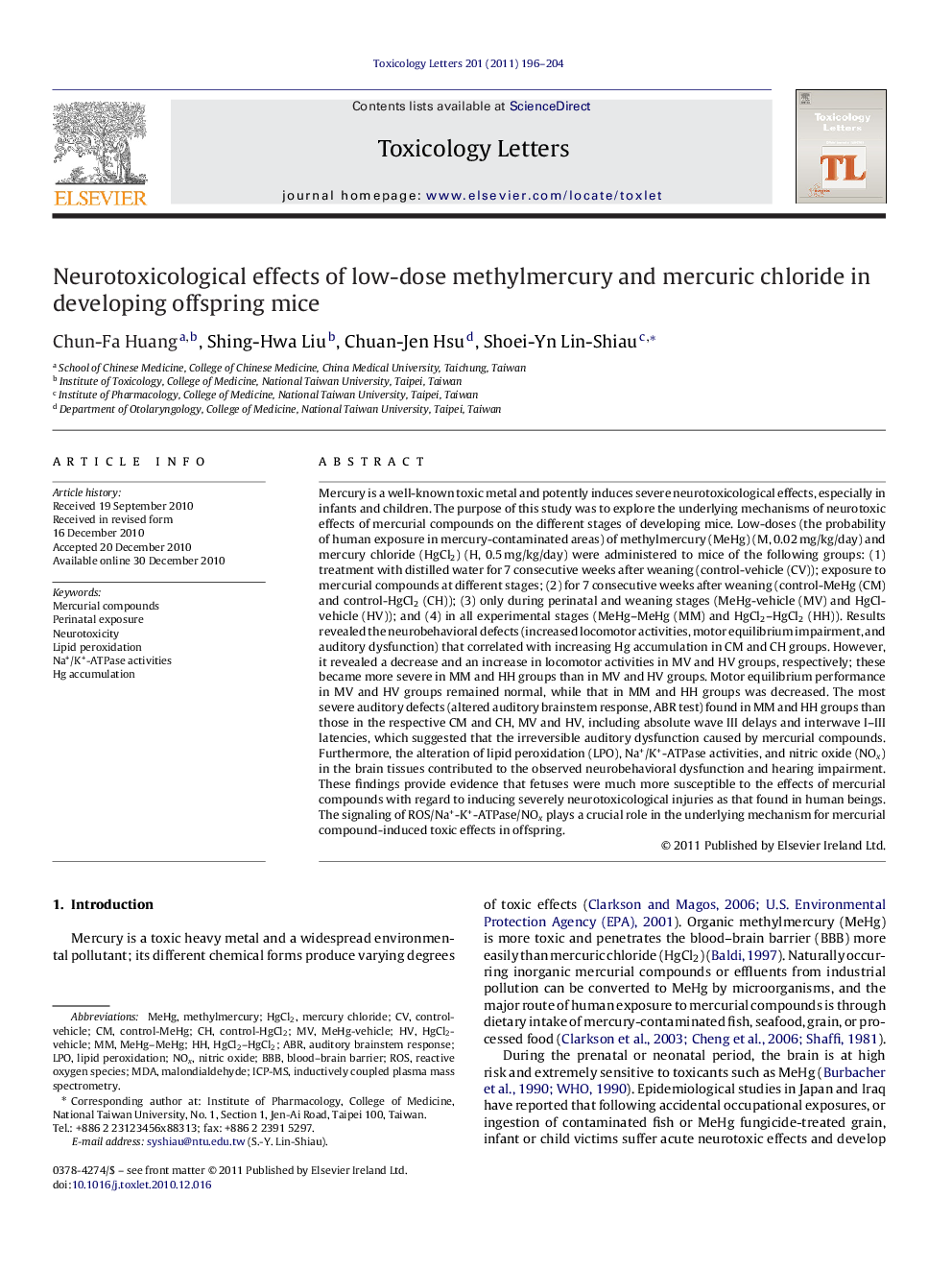| کد مقاله | کد نشریه | سال انتشار | مقاله انگلیسی | نسخه تمام متن |
|---|---|---|---|---|
| 5860768 | 1133239 | 2011 | 9 صفحه PDF | دانلود رایگان |
عنوان انگلیسی مقاله ISI
Neurotoxicological effects of low-dose methylmercury and mercuric chloride in developing offspring mice
دانلود مقاله + سفارش ترجمه
دانلود مقاله ISI انگلیسی
رایگان برای ایرانیان
کلمات کلیدی
MDAHgCl2LPOABRMeHgNOx - NOXROS - ROSBBB - سد خونی مغزیBlood–brain barrier - سد خونی مغزیNeurotoxicity - سمیت عصبیICP-MS - طیفسنجی جرمی پلاسمای جفتشده القاییinductively coupled plasma mass spectrometry - طیفسنجی جرمی پلاسمای جفتشده القاییPerinatal exposure - قرار گرفتن در معرض پریناتالmalondialdehyde - مالون دی آلدهیدMethylmercury - متیل کرکریNitric oxide - نیتریک اکسیدauditory brainstem response - پاسخ شنوایی مغزLipid peroxidation - پراکسیداسیون لیپیدMercury chloride - کلرید جیوهReactive oxygen species - گونههای فعال اکسیژن
موضوعات مرتبط
علوم زیستی و بیوفناوری
علوم محیط زیست
بهداشت، سم شناسی و جهش زایی
پیش نمایش صفحه اول مقاله

چکیده انگلیسی
Mercury is a well-known toxic metal and potently induces severe neurotoxicological effects, especially in infants and children. The purpose of this study was to explore the underlying mechanisms of neurotoxic effects of mercurial compounds on the different stages of developing mice. Low-doses (the probability of human exposure in mercury-contaminated areas) of methylmercury (MeHg) (M, 0.02Â mg/kg/day) and mercury chloride (HgCl2) (H, 0.5Â mg/kg/day) were administered to mice of the following groups: (1) treatment with distilled water for 7 consecutive weeks after weaning (control-vehicle (CV)); exposure to mercurial compounds at different stages; (2) for 7 consecutive weeks after weaning (control-MeHg (CM) and control-HgCl2 (CH)); (3) only during perinatal and weaning stages (MeHg-vehicle (MV) and HgCl-vehicle (HV)); and (4) in all experimental stages (MeHg-MeHg (MM) and HgCl2-HgCl2 (HH)). Results revealed the neurobehavioral defects (increased locomotor activities, motor equilibrium impairment, and auditory dysfunction) that correlated with increasing Hg accumulation in CM and CH groups. However, it revealed a decrease and an increase in locomotor activities in MV and HV groups, respectively; these became more severe in MM and HH groups than in MV and HV groups. Motor equilibrium performance in MV and HV groups remained normal, while that in MM and HH groups was decreased. The most severe auditory defects (altered auditory brainstem response, ABR test) found in MM and HH groups than those in the respective CM and CH, MV and HV, including absolute wave III delays and interwave I-III latencies, which suggested that the irreversible auditory dysfunction caused by mercurial compounds. Furthermore, the alteration of lipid peroxidation (LPO), Na+/K+-ATPase activities, and nitric oxide (NOx) in the brain tissues contributed to the observed neurobehavioral dysfunction and hearing impairment. These findings provide evidence that fetuses were much more susceptible to the effects of mercurial compounds with regard to inducing severely neurotoxicological injuries as that found in human beings. The signaling of ROS/Na+-K+-ATPase/NOx plays a crucial role in the underlying mechanism for mercurial compound-induced toxic effects in offspring.
ناشر
Database: Elsevier - ScienceDirect (ساینس دایرکت)
Journal: Toxicology Letters - Volume 201, Issue 3, 25 March 2011, Pages 196-204
Journal: Toxicology Letters - Volume 201, Issue 3, 25 March 2011, Pages 196-204
نویسندگان
Chun-Fa Huang, Shing-Hwa Liu, Chuan-Jen Hsu, Shoei-Yn Lin-Shiau,